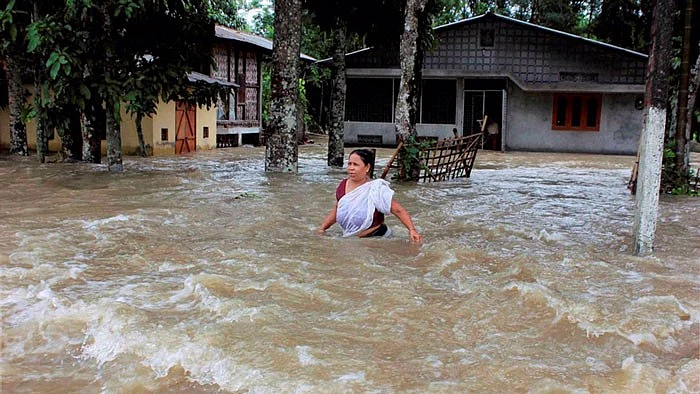Over a lakh people have been left affected in the first wave of Assam’s flood this year that struck 28 villages in Lakhimpur, Jorhat and Biswanath districts. And this is just the beginning of June – the floods generally start getting worse in the months of July and August.
Each year, river Brahmaputra that flows through Assam like a lifeline has also wreaked havoc in the state; the past few years have seen a rapid destruction of infrastructure and biodiversity areas in Assam due to floods.
According to a report by the Assam State Disaster Management Authority (ASDMA), 1,01,809 people are reeling under the floods in the two districts, where 140 villages are under water. The calamity has damaged crops in 385.67 hectares of land.
Losses to Crops, Infrastructure and Lives
The calamity has damaged crops in 385.67 hectares of land. Karimganj – the worst affected – has over 97,000 people hit by the flood, while more than 4,500 people were hit in Lakhimpur, the report said. Out of the total number of affected, only about 113 people are taking shelter in relief camps.
As per the National Flood Commission of India, Brahmaputra valley is one of the most hazard-prone regions. Despite setting up various flood management committees and bodies such as Central Water Commission (CWC) set up in 1945, Brahmaputra Board set up in 1980, Ganga Flood Control Mission formed in 1972 and the National Disaster State Management Authority constituted in 2005, their role in effective flood control remains unclear and efficient management of floods still remains a distant reality.
Inaction Despite Expert Committees
Programmes such as FLEWS (Flood Early Warning System), which sought to provide early warnings about floods in magnitude, region and probable time, seem to have been ineffective in securing the response to floods.
Even the infrastructural damage to embankments, dykes, roads, bridges, schools, etc. lead to a loss of several hundred crores to the state. Then why are there no measures to manage this disaster?
Existing Governmental Initiative and Policies
- High Level Committee On Floods – 1957 & Policy Statement of 1958
- National Flood Commission (Rashtriya Barh Ayog) – 1980
- Expert Committee to Review the Implementation of the Recommendations of National Flood Commission-2003 (R Rangachari Committee)
- National Water Policy -1987/ 2002/2012
Archaic Data-Based Planning
The primary cause of the repeated damage by floods, is what experts believe, the fault in the structures that are meant to control the flood.
The embankments along Brahmaputra and its tributaries, which were built on the basis of the 1954 recommendations of the Rashtriya Barh Ayog have shown signs of aging, a report in The Indian Express stated. The problem in the structures is that they were built keeping in mind two decade-old flood data, which is starkly different from the current data.
Over the past 60 years, successive governments have built levees along most of the Brahmaputra, but experts say the embankments are not only poorly maintained, but are a discredited form of flood management, according to a report by Reuters.
Moreover, these embankments are used by commuters and also by villagers who sometimes build bamboo huts around it.
Faulty planning going hand in hand with climatic changes and human activities make the matter worse.
What RTIs Reveal
The lack of research in the area of flood control contributes to worsening the perennial aftermath of floods. RTIs filed by The Quint reveal that the Environment Ministry has spent less than half a percent of its already dipping annual budget on research. From 2012-2013 to 2016-2017, the average percent of the budget spent on research is 0.24 percent.
The failure of preventive measures, the slow response of government authorities, and the absence of effective plans to mitigate floods demonstrate an urgent need to reevaluate strategies concerning the same.
There is a growing need of pro-active efforts on part of the government to enhance the quality of response to environmental concerns affecting millions across the country. Between 2012-2013 and 2016-2017, the government budget for environment has been slashed by 19 percent. This clearly shows the nature of government reaction to the issue of environment and sustainability.
